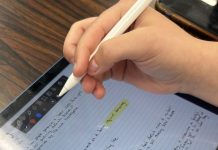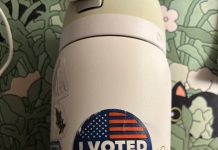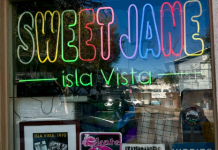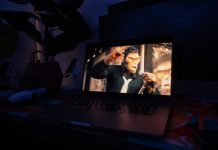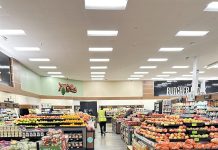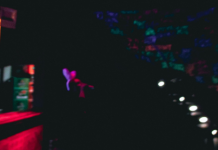Jenny Hong
As a first-year undergraduate student, I had no idea what to expect at a graduate conference. In fact, everything I expected a conference to be was totally shattered as soon as I stepped inside the McCune Conference room. Instead of finding rows of chairs and a podium for the guest speaker, Karen Anzoategui, the chairs were stacked and the room was bare. The rest of the audience and I were told to either grab a chair if we wanted or to stay standing. Right then and there, I knew that this conference wasn’t how I imagined it to be. It was a lot more casual and comfortable. There were about 11-12 people in the audience, including myself, and eight performers in the room. We were told by the organizers that the conference wasn’t only going to be held in the room. In fact, we were told that we will be moving to two different settings: the hallway outside of the McCune conference room and the coffee room on the same floor. The organizers handed us a white card and a pen and were instructed to write down our emotions, captions for performances, and any other comments. Soon enough, I was captivated by their unconventional methods and was excited to see what would happen next.
In the first setting, there were about six to seven people who were acting as “clay” and six to seven people who were “sculptors.” Both sculptors and clay were provided with a prompt, a one-word adjective or a noun, and the prompt was not shown to the audience. Then, the “sculptors” proceeded to move and twist the bodies of the “clay” to represent the prompt. The “clay” were in frozen position and as soon as the “sculptors” were finished with their “clay,” they were told to take a step back and allow the audience to observe their masterpieces. The audience had to write down captions for these sculptures and some of the words I jotted down were “warzone” and “what politics should not be.” Furthermore, the organizers encouraged the audience to stand up and view the artworks in different angles of the room. They explained that a different story could be told by viewing these art pieces from different angles. These human sculptures literally represented real clay sculptures that you would see in art museums. This was definitely the highlight of the entire experience. It allowed us to truly connect with the performers, not as an audience who came to listen to a boring, ordinary guest speaker, but as an audience who came to an art museum.
When I first heard of “Bodies in Space” I didn’t really know what that meant, but after the first performance, I began to understand.
“[We] decided it would be an awesome idea to try to bring, you know, more nontraditional forms of scholarships into the academy, and what would it look like for a bunch of graduate students to get together instead of reading papers that were prepared in advance, actually using our bodies to think through our ideas and our scholarship—so what would an embodied practice of community making look like,” said Alison Reed, a fourth-year PHD student who is also one of the co-organizers for this event. “That was the original idea of the conference, and so we decided to use performance methods, so this year we used first ample theater the oppressed performance methods and forms of coalition building to create these performance pieces that you saw today.”
After the three performance pieces in the conference room, the audience and I were told to move to the hallway for the next piece. Up to this point, I thought I had a pretty good idea of what each performance represented. However, the scene I was looking at in the hallway blew me away. Just imagine would it would be like if you were looking down a hallway and you saw some people on the floor reaching out with their hands, some people gliding across the floor, some other people spinning around with their arms open, and the rest of the them doing other random things. Although this performance was pretty difficult to comprehend, the next performance was even more bizarre.
Once again the audience and I moved back to the McCune conference room. The organizers explained to us that this last performance was for one person at a time. While waiting for my turn, I observed the faces of those who went before me. They were all smiling as if they shared a secret with each other. The more I waited, the more anxious I was to see what everyone else saw. When it was my turn, I looked inside to see five people in a small, cramped coffee room. I was encouraged to go inside and sit on a stool in the middle of the small room. As soon as I sat down, the first thing I wanted to do was get out. The experience was very uncomfortable because I was in such a tight space, but that wasn’t the only problem. The whole atmosphere of the room was eerie and the actions of the performers were really strange. One woman was sitting on top of the refrigerator, while opening and closing the top cabinet door. Another woman, wearing an orange jail pants, was sitting on the counter with cards in her hands. Another woman was opening and closing a small oven. There was also a man writing on a paper, which was attached to the refrigerator, and he was also pulling out a table and pushing it back in. All of these four performers’ actions were repetitive and uncomfortable to watch. Nevertheless, the creepiest action of these performers was the last performer, who was in a bucket with her eyes closed. She wasn’t moving at all, which completely contradicted the actions of the rest of the performers. The entire room was chaotic, except for this woman lying in a bucket. I could not handle nor understand all the abstractness of this performance.
After the last performance, the organizers held a small Q&A session. During this time, the audience members were allowed to ask questions and to share what they thought about each performance. They also shared what they wrote on their white cards and the performers, in return, shared the prompts they received. Most of their performances were impromptu, especially their hallway scene. I think that explained why everyone were doing random things. The main point of this all was to see how the performers’ bodies worked within the space they were in. This was also the reason why they changed settings; the reason was to show how their bodies moved in different spaces.
All in all, I really enjoyed this unconventional graduate conference. I think it really pushed us out of our comfort zones and allowed us to see how using our bodies can help bring new ideas. For more information on graduate conferences, contact the interdisciplinary humanities center at www.ihc.ucsb.edu.

